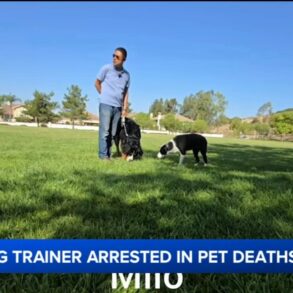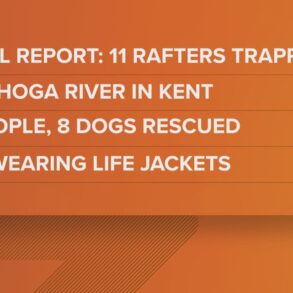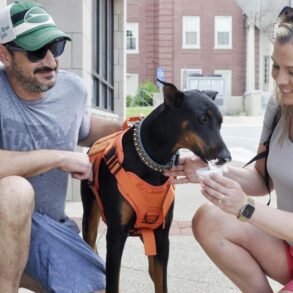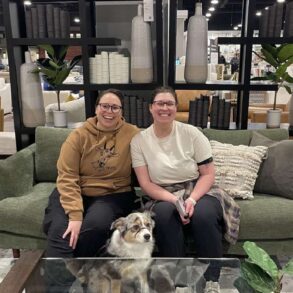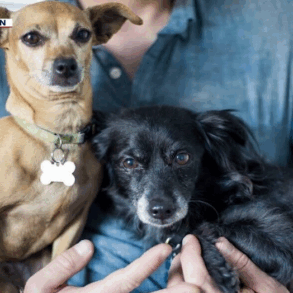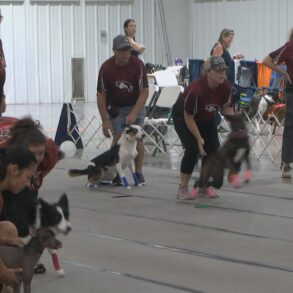Speaker 1(00:00):
It is, believe it or not, national train your dog
months and I have. We had, as you know, until recently,
two awesome little dogs, one passed away.
Speaker 2 (00:09):
Now we have one awesome little dog.
Speaker 1 (00:12):
I can’t say she’s always the best behaved. Joining us
to talk about how we might all do better as
doggy parents.
Speaker 2 (00:21):
Is Brad Feiffer.
Speaker 1 (00:22):
He is executive director of the Certification Council for Professional
Dog Trainers.
Speaker 2 (00:28):
Hey, Brad, thanks for joining us.
Speaker 3 (00:29):
Appreciate it, no problem, Thank you for having me.
Speaker 1 (00:32):
So before we get into the doggy stuff, what exactly
does your group do?
Speaker 4 (00:37):
The Certification Council for Professional Dog Trainers is a independent
creditioning organization for dog trainers. The trainers carrying our credential
have demonstrated competence in the field, are being held accountable
to these standards of practice and code of ethics, and
regularly participate in continuing education. It’s really important to know
(00:58):
that dog training is an on licensed profession. Anyone can
hang their hat offer services to the public without having
first demonstrated competence in the field.
Speaker 2 (01:09):
Yeah, that’s interesting.
Speaker 1 (01:10):
So I guess you believe your certification is a mark
of competence, and as you said, meeting ethics standards and
that sort of thing.
Speaker 2 (01:21):
So, yeah, that’s an interesting thing.
Speaker 1 (01:22):
And then I guess these days, these days, a lot
is done with online reviews, which becomes its own sort
of mark of acceptability.
Speaker 4 (01:29):
I guess maybe to it to agree, But sometimes those
online reviews have no real context. So I think, you know,
having someone who has demonstrated competence in their field. You know,
whether you’re a hairdresser, a CPA, a doctor, you know
a lot of professions. Most professions have competency standards before
they are offering services to the public, and that should
go above and beyond you know, online reviews. Those are
(01:51):
certainly one factor for finding an effective dog trainer, a
safe dog trainer. Veterinarian referrals are another factor.
Speaker 2 (01:59):
Yeah, okay, what about.
Speaker 1 (02:03):
So this is not so much about your organization, what
in your experience? What percentage of dog owners can actually
do a good enough.
Speaker 2 (02:12):
Job training their own dogs?
Speaker 3 (02:14):
Well, I think, I mean, I.
Speaker 4 (02:15):
Think a lot of dog owners do a really nice
job teaching their dogs, you know, the basic skills.
Speaker 3 (02:20):
I mean everyone or not everyone, but a lot of people.
Speaker 4 (02:22):
Do a good job of teaching their dog to potty outside,
going their create on queue, sit and lie down, come
and call in the backyard. A lot of times, though,
dog trainers can be brought in when somebody either is
a little unsure about how to meet their dog’s needs,
how to incorporate training kind of beyond the elementary sit,
come in the house behaviors into more advanced behaviors outside off.
Speaker 3 (02:46):
Leash with distractions.
Speaker 4 (02:49):
And I think a lot of dog owners today are
taking a more proactive approach to training right puppy socialization,
starting off on the right track with your adolescent dog
to teach the foundations skills in hopes that they are
preventing future behavior problems related to fears, phobia’s, aggression and
those sort of things.
Speaker 1 (03:08):
All right, So I’ll ask you a question about my
specific dog, who is surprisingly in a way, surprisingly under control.
So she’s a two two and a half year old
English bulldog and absolutely hilarious, and you know, bulldogs tend
to be.
Speaker 2 (03:27):
Very sweet, and she is, and she’s actually pretty good.
Speaker 1 (03:31):
We live in a very quiet little neighborhood and we
will walk around without her on a leash and when
we call her, she comes right back.
Speaker 2 (03:38):
She doesn’t go to and it’s all good.
Speaker 1 (03:40):
Our main issue with her right now is she loves
new people, and so when the Amazon delivery guy comes
to the house or a friend of mine comes over,
she’ll jump on them.
Speaker 2 (03:51):
You know, She’ll put her her front feet up on their.
Speaker 1 (03:54):
Thigh and if I like yell at her get.
Speaker 2 (03:57):
Off, she’ll she’ll get off generally, but then she’ll do
it again. So you got any advice for me?
Speaker 4 (04:02):
Yeah, I would take you know, it sounds like you’ve
done a really great job at foundation training.
Speaker 3 (04:05):
I would spend thirty or forty five days.
Speaker 4 (04:08):
I would have a leash nearby, and each time someone
came out of the house, I would take the take
five seconds, put on a leash, walk her up, teach
her to sit next to you before people pet her.
What she wants is engagement. It sounds like say hello
to the Amazon guy. Maybe the Amazon guy’s giving her
a treat every now and then see your company, and inevitably,
because she’s awful leash, she’s practicing a behavior pattern that
(04:31):
you’d like to.
Speaker 3 (04:32):
See changed, but she finds reinforcing.
Speaker 4 (04:35):
So let’s just take one step back, manage her a
little bit with a leash and collar when people are
coming over, and practice sit first, and then say Hello,
sit first and then say hello, and that will I
think start creating a better behavior pattern for you, more
desirable behavior pattern for you.
Speaker 1 (04:49):
I have a listener question, and by the way, folks,
if you haven’t work, if you have a listener question
for Brad about dog training and dog trainers, text it
in in five six, six nine zero. You know, in
the next few minutes while I’m talking to Brad, a
listener wants to know if it’s possible to train a pug.
Speaker 3 (05:06):
It’s possible to train any dog.
Speaker 4 (05:09):
Certain breeds have a reputation for being less trainable. Sometimes
toy breeds get that stereotype, but typically if an owner
commits to a clear goal and works with either you know,
there’s a lot of online programs also a Certified Professional
Dog Trainer through the CCPDT, every breed is trainable.
Speaker 2 (05:28):
Is it true that poodles are really smart?
Speaker 1 (05:32):
You know?
Speaker 4 (05:32):
I have said since I was a young, young dog
trainer that if everyone had a well bred standard poodle,
dog trainers would be going out of work. I think
poodles are one of the most versatile breeds on the planet.
They’re athletic without being hyper. They are wicked smart. They
are adaptable. You know, you can either take them hiking
all day or you can see on accounts all day.
Speaker 3 (05:53):
It’s a really great breed.
Speaker 4 (05:54):
And people have got to get past the traditional show trims.
But they can be they can be room in any
style you want, So I think a lot of people
would would really enjoy a poodle, a well bred poodle,
if they’re around one.
Speaker 1 (06:06):
How much of those positive characteristics about poodles typically exist
in the fill in the blank doodles?
Speaker 4 (06:17):
Again, doodles are there’s I think, from my opinion, there’s
more variability in the doodles, but doodles are also they’ve
been designed to be friendly with people, outgoing, adaptable. I
think maybe one of the things that doodles don’t have
the standard pools do, for instance, is you know, standard
poodles have years and years and years of purposeful breeding
(06:38):
behind them for specific temperament traits, and there’s a lot
of people in the market that are breeding doodles just
for the sake of breeding doodles that might not have
as much purpose behind their breeding decisions.
Speaker 1 (06:50):
We’re talking with Brad Pfeiffer from the Certification Council for
Professional Dog Trainers CCPD dot org.
Speaker 2 (07:01):
Is that right? And I get that right?
Speaker 3 (07:02):
That is it? Yes?
Speaker 4 (07:03):
Correct?
Speaker 2 (07:03):
Thank you CCPDT dot org.
Speaker 1 (07:06):
And what can folks find on your website and can
they find good trainers in their area on that website? Yeah?
Speaker 4 (07:14):
I mean if you’re a dog training professional who’s looking
at getting certified, CCPDT dot org is a great resource
for you. If you’re a pet owner looking for a
trainer in your area, or maybe some information on how
to manage or begin training your new dog at home,
then they can visit Fetch Theanswer dot com. That is
ccpdt’s public facing website. Again again, it trained has a
(07:38):
trainer directory on the front page where you can search
by trainers in your city or zip code and get
connected with someone who can help you with your training needs.
Speaker 1 (07:47):
What’s the most common mistake that new dog owners make
in this realm.
Speaker 4 (07:55):
Not being disciplined enough, and I don’t mean disciplined in
terms of punishment, just not.
Speaker 3 (08:00):
Being as consistent with their follow through. You know, we
can be consistent about.
Speaker 4 (08:03):
Certain things, like we always make our dogs sit for
their dinner bowl, but we’re not as consistent about applying
our expectations at the.
Speaker 3 (08:09):
Front doorway, for instance.
Speaker 4 (08:10):
Or we may allow and encourage our dogs to jump
up on us because we love them, but then we
want to, you know, discourage them from jumping up.
Speaker 3 (08:18):
On our company.
Speaker 4 (08:19):
And those variations on our expectations can create conflict and
it can actually increase, you know, the behavior that that
cause us frustration.
Speaker 1 (08:28):
Let me see if that I got a bunch of
listener questions here, and let me just see if any
of them are particularly interesting. What should I do when
an unleashed dog wants to sniff me while I’m walking
on a trail?
Speaker 2 (08:41):
I don’t want dogs in my space?
Speaker 1 (08:44):
Yep.
Speaker 3 (08:45):
So there’s a couple of quick and easy tips.
Speaker 4 (08:47):
Something that’s really easy that can sometimes work for certain
dogs is if you carry some dog kibbler treats with you,
and as the dog approaches you, you can just throw treats
at the dog. That way, it distracts them and they
kind of start sniffing the ground for their treats.
Speaker 3 (09:00):
One that’s one option.
Speaker 4 (09:01):
Another option would be to put your hand out and
say stop, kind of confidently.
Speaker 3 (09:06):
That can sometimes halt a dog from entering your space.
Speaker 4 (09:10):
And then if you see that the dog is accompanied
by an owner, certainly just asking them to call their
dog off or put their dog.
Speaker 3 (09:17):
Gonna leash should be you know.
Speaker 4 (09:19):
Somewhat accepted by most most most dog owners out in
a respectful way.
Speaker 1 (09:24):
How do I find someone to train my dog to
be a therapy dog?
Speaker 4 (09:29):
There are a number of dog trainers who specialize in
therapy work. I would first visit the CCPDT website and
look under the trainer directory for trainers in your area,
and then from there when you’re doing your when you’re
going through the trainer’s website, just look for specialty services
around therapy dog type work or animalissisted therapy type work.
Speaker 3 (09:54):
You can also google search.
Speaker 4 (09:56):
Just animal sisted therapy UH in your or your town
to see what trainers may come up with. And just
make sure that you’re doing your due diligence to that
the trainer has been certified and that they actually specialize
or have experience in the animal assistant therapy activities that
you want to participate in.
Speaker 1 (10:15):
Let’s see our two year old burn doodle. Is that
I guess a Bernie Mountain dog in a poodle exactly? Yep,
A burn a doodle won’t come in the house from
the backyard no matter what treats we offer. Yep.
Speaker 4 (10:31):
So I would say for the next month, the dog
goes outside on a long line, and we’re going to
first start practicing comen called for food treats in the house,
food treats outside, or even toys if your dog is
really motivated by toys. But we start going outside with
our dog, they’re on a fifteen or twenty foot long line,
(10:51):
so we’ve already practiced training in the con in the
area that we want them to listen. And then when
we’re sending them out for potty breaks, we’re going to
have them on a long line. So when we say Sophie, come,
we can you know, reinforce it, but also facilitate the
response and we’re not in a situation where the dog
is walking away from us or running around the backyard.
(11:11):
Owners have to be able to, you know, train the
skill that they want their dog to do, but also
incorporate the skill into the routine. And we also got
to figure out why does the dog not want to
come in. Some dogs really enjoy being outside. And if
there’s moments where you call your dog in the house
and they don’t come, so you close the door and say, okay, fine,
five more minutes, then you’re actually unintentionally.
Speaker 3 (11:32):
Training them to be avoidant of coming in the house.
Speaker 1 (11:35):
All right, listen, just give me a couple more, and folks,
I appreciate, I appreciate all your questions. I’m not going
to get to all of them. Do you have an
opinion about retractable leashes.
Speaker 4 (11:47):
Retractable leases, she’s releases have their place.
Speaker 3 (11:51):
I would not encourage.
Speaker 4 (11:52):
You to walk your dog in a public setting, necessarily
along your sidewalk or in a high traffic area unretractable leash,
because there are some safety concerns with you drop the
leash or the leash snapping back and you being injured
as a handler. But certainly retractable leashes can be used
safely and effectively to teach our dog to come back
(12:13):
to us from a distance, to exercise our dog if
we’re on a road trip, or if you know I
live in an apartment. An alternative to the retractable leash
would be a long line, which is usually ten feet
fifteen feet twenty feet, which you know some trainers feel
is safer than the retractable, But there certainly is there
is a time and a place that the retractable can
(12:35):
be effective.
Speaker 3 (12:36):
But do be conscientious about.
Speaker 4 (12:39):
Owner injuries with the leash coming out too quickly or
popping off and burning you. And when we talk about
long line work or retractable leash work, we also want
to make sure that the dogs are not running quickly
and then hitting the end of the leash because that
would also cause injury. So a lot of times I’m using,
(13:01):
like a body harness with a back clip could be another,
you know, safer alternative compared to a neck callar. Got it?
Speaker 1 (13:08):
Yeah, we uh with our little English bulldog who’s not
running at a high enough rate of speed too to try.
Very risky, but we do use the harness with the
back clip, and we do not use a retractable or
retractable leash. All right, last listener question that I’m gonna
have time for today. My dog listens to me into
my son, but not to my wife.
Speaker 2 (13:30):
Why would that be?
Speaker 4 (13:33):
I always are using the analogy sometimes where you’ll hear
a mother go, do you me to call your father?
And I can’t tell you the rhyme or reason for it,
but I feel like that’s that’s a common occurrence. What
I would say is that you know, dogs will oftentimes
pattern in their behavior based on.
Speaker 3 (13:47):
Who they’re with and where they are.
Speaker 4 (13:49):
Sometimes dogs might appear to listen better to a man
than a woman because of a ton of voice or
body language.
Speaker 3 (13:56):
But a lot of it will come down to.
Speaker 4 (13:58):
Simply the wife might need to spend more time actually
training the dog.
Speaker 3 (14:04):
I don’t know does does she feed the dog? Does
she walk the dog? Does she ever put the dog
on a leash and collar? Just kind of go through, sit,
come down.
Speaker 4 (14:12):
I would really work with a trainer in your area
to try to determine what might be the reason that
the dog is less responsive to one member of the
family over another and just put in a basic training
plan to to to change that.
Speaker 2 (14:27):
Love it. That’s that’s great stuff, folks. This is National
Train your Dog Month.
Speaker 1 (14:32):
You get more information about certification of professional Dog trainers
at the Certification Council for Professional Dog Trainers CCPDT dot org.
Brad let me mention, I think your website might be
having a problem right now, so maybe go check that
because on two different devices I can’t access it.
Speaker 2 (14:51):
But what was the other website that you gave.
Speaker 3 (14:54):
So it’s ccp DT dot org. And then and then
fetch the answer.
Speaker 2 (14:59):
Dot Fetch the answer dot com.
Speaker 1 (15:02):
All right, grad fie for thanks so much for your time,
great conversation, really enjoyed it
Speaker 2 (15:05):
Thank you, Thank you all right, see you bye.
This post was originally published on this site be sure to check out more of their content.






